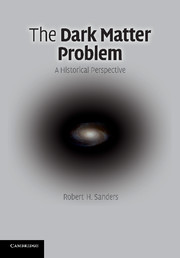Book contents
- Frontmatter
- Contents
- Acknowledgements
- 1 Introduction
- 2 Early history of the dark matter hypothesis
- 3 The stability of disk galaxies: the dark-halo solution
- 4 Direct evidence: extended rotation curves of spiral galaxies
- 5 The maximum-disk: light traces mass
- 6 Cosmology and the birth of astroparticle physics
- 7 Clusters revisited: missing mass found
- 8 CDM confronts galaxy rotation curves
- 9 The new cosmology: introducing dark energy
- 10 An alternative to dark matter: modified Newtonian dynamics
- 11 Seeing dark matter: the theory and practice of detection
- 12 Reflections: a personal point of view
- Appendix Astronomy made simple
- References
- Index
11 - Seeing dark matter: the theory and practice of detection
Published online by Cambridge University Press: 05 July 2014
- Frontmatter
- Contents
- Acknowledgements
- 1 Introduction
- 2 Early history of the dark matter hypothesis
- 3 The stability of disk galaxies: the dark-halo solution
- 4 Direct evidence: extended rotation curves of spiral galaxies
- 5 The maximum-disk: light traces mass
- 6 Cosmology and the birth of astroparticle physics
- 7 Clusters revisited: missing mass found
- 8 CDM confronts galaxy rotation curves
- 9 The new cosmology: introducing dark energy
- 10 An alternative to dark matter: modified Newtonian dynamics
- 11 Seeing dark matter: the theory and practice of detection
- 12 Reflections: a personal point of view
- Appendix Astronomy made simple
- References
- Index
Summary
Non-gravitational detection of dark matter
Anyone who thinks objectively about the concordance model of the Universe must surely be concerned that 80% of the matter content of the Universe has never been detected independently of its global gravitational effects in large, and generally distant, astronomical systems. It is a bit as though Neptune had never been discovered after having been postulated to account for the anomalous motion of Uranus. Not only has the non-baryonic particle matter never been seen (it is of course, dark), but we have no definite idea of the identity of these putative cold dark matter particles. As discussed in Chapter 6, there are no known “standard-model” particles that fit the bill – they must be electrically neutral, stable and slow moving (cold). But reasonable extensions of the standard model of particle physics do provide a number of candidates, and, of these, perhaps the most well-motivated is the LSP, the “lightest superpartner” that should exist in the context of the theory of supersymmetry.
To summarize the discussion in Section 6.4, the basis of supersymmetry is that every known particle has a partner that differs by a half-integral spin; for example, the partner of the spin 1 photon is the spin 1/2 photino. This proposed symmetry between integral spin particles, bosons, and half-integral spin particles, fermions, rather successfully confronts a number of theoretical problems in physics, although, so far, there is no direct experimental verification of supersymmetry. But the theory does, in effect, double the number of possible particles.
- Type
- Chapter
- Information
- The Dark Matter ProblemA Historical Perspective, pp. 150 - 165Publisher: Cambridge University PressPrint publication year: 2010



